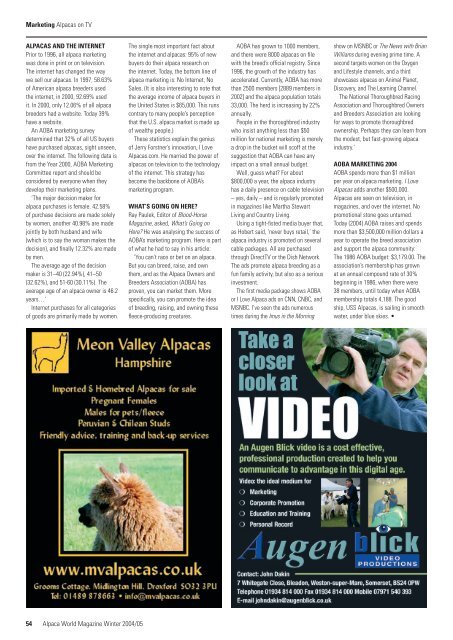Create successful ePaper yourself
Turn your PDF publications into a flip-book with our unique Google optimized e-Paper software.
Marketing <strong>Alpacas</strong> on TV<br />
ALPACAS AND THE INTERNET<br />
Prior to 1996, all alpaca marketing<br />
was done in print or on television.<br />
The internet has changed the way<br />
we sell our alpacas. In 1997, 58.63%<br />
of American alpaca breeders used<br />
the internet, in 2000, 92.69% used<br />
it. In 2000, only 12.06% of all alpaca<br />
breeders had a website. Today 39%<br />
have a website.<br />
An AOBA marketing survey<br />
determined that 32% of all US buyers<br />
have purchased alpacas, sight unseen,<br />
over the internet. The following data is<br />
from the Year 2000, AOBA Marketing<br />
Committee report and should be<br />
considered by everyone when they<br />
develop their marketing plans.<br />
‘The major decision maker for<br />
alpaca purchases is female. 42.58%<br />
of purchase decisions are made solely<br />
by women, another 40.98% are made<br />
jointly by both husband and wife<br />
(which is to say the woman makes the<br />
decision), and fi nally 12.32% are made<br />
by men.<br />
The average age of the decision<br />
maker is 31–40 (22.94%), 41–50<br />
(32.62%), and 51-60 (30.11%). The<br />
average age of an alpaca owner is 46.2<br />
years…’<br />
Internet purchases for all categories<br />
of goods are primarily made by women.<br />
54 Alpaca World Magazine <strong>Winter</strong> 2004/05<br />
The single most important fact about<br />
the internet and alpacas: 95% of new<br />
buyers do their alpaca research on<br />
the internet. Today, the bottom line of<br />
alpaca marketing is: No Internet, No<br />
Sales. (It is also interesting to note that<br />
the average income of alpaca buyers in<br />
the United States is $65,000. This runs<br />
contrary to many people’s perception<br />
that the U.S. alpaca market is made up<br />
of wealthy people.)<br />
These statistics explain the genius<br />
of Jerry Forstner’s innovation, I Love<br />
<strong>Alpacas</strong>.com. He married the power of<br />
alpacas on television to the technology<br />
of the internet. This strategy has<br />
become the backbone of AOBA’s<br />
marketing program.<br />
WHAT’S GOING ON HERE?<br />
Ray Paulek, Editor of Blood-Horse<br />
Magazine, asked, What’s Going on<br />
Here? He was analysing the success of<br />
AOBA’s marketing program. Here is part<br />
of what he had to say in his article:<br />
‘You can’t race or bet on an alpaca.<br />
But you can breed, raise, and own<br />
them, and as the Alpaca Owners and<br />
Breeders Association (AOBA) has<br />
proven, you can market them. More<br />
specifi cally, you can promote the idea<br />
of breeding, raising, and owning these<br />
fl eece-producing creatures.<br />
AOBA has grown to 1000 members,<br />
and there were 8000 alpacas on fi le<br />
with the breed’s offi cial registry. Since<br />
1996, the growth of the industry has<br />
accelerated. Currently, AOBA has more<br />
than 2500 members [2889 members in<br />
2002] and the alpaca population totals<br />
33,000. The herd is increasing by 22%<br />
annually.<br />
People in the thoroughbred industry<br />
who insist anything less than $50<br />
million for national marketing is merely<br />
a drop in the bucket will scoff at the<br />
suggestion that AOBA can have any<br />
impact on a small annual budget.<br />
Well, guess what? For about<br />
$800,000 a year, the alpaca industry<br />
has a daily presence on cable television<br />
– yes, daily – and is regularly promoted<br />
in magazines like Martha Stewart<br />
Living and Country Living.<br />
Using a tight-fi sted media buyer that,<br />
as Hobert said, ‘never buys retail,’ the<br />
alpaca industry is promoted on several<br />
cable packages. All are purchased<br />
through DirectTV or the Dish Network.<br />
The ads promote alpaca breeding as a<br />
fun family activity, but also as a serious<br />
investment.<br />
The fi rst media package shows AOBA<br />
or I Love Alpaca ads on CNN, CNBC, and<br />
MSNBC. I’ve seen the ads numerous<br />
times during the Imus in the Morning<br />
show on MSNBC or The News with Brian<br />
Williams during evening prime time. A<br />
second targets women on the Oxygen<br />
and Lifestyle channels, and a third<br />
showcases alpacas on Animal Planet,<br />
Discovery, and The Learning Channel.<br />
The National Thoroughbred Racing<br />
Association and Thoroughbred Owners<br />
and Breeders Association are looking<br />
for ways to promote thoroughbred<br />
ownership. Perhaps they can learn from<br />
the modest, but fast-growing alpaca<br />
industry.’<br />
AOBA MARKETING 2004<br />
AOBA spends more than $1 million<br />
per year on alpaca marketing. I Love<br />
<strong>Alpacas</strong> adds another $500,000.<br />
<strong>Alpacas</strong> are seen on television, in<br />
magazines, and over the internet. No<br />
promotional stone goes unturned.<br />
Today (2004) AOBA raises and spends<br />
more than $3,500,000 million dollars a<br />
year to operate the breed association<br />
and support the alpaca community:<br />
The 1986 AOBA budget: $3,179.00. The<br />
association’s membership has grown<br />
at an annual compound rate of 30%<br />
beginning in 1986, when there were<br />
38 members, until today when AOBA<br />
membership totals 4,188. The good<br />
ship, USS <strong>Alpacas</strong>, is sailing in smooth<br />
water, under blue skies.







